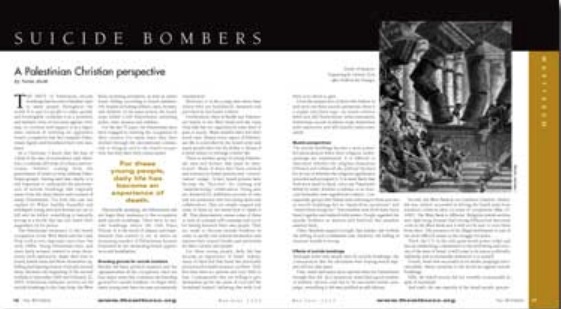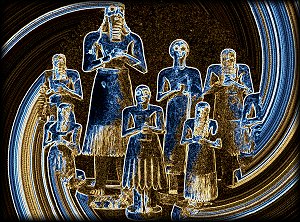Darn it. I mixed up the numbering of my response to Wright series and left out “3”. So let this one be #3, even if it’s only an indirect response.
The gospels failed to settle the argument
The mere fact that John’s gospel presents Jesus as a palpable body, one that could be felt by Thomas, did not necessarily “prove” to ancient readers that Jesus was physical flesh and blood. I listed some of the different accounts of spirits in my previous (#5 response) post that showed they could in several cases eat and drink, wear clothes, touch and be touched, etc.
In the gospel of Luke the author chose to have Jesus explain to his disciples that a spirit does not have flesh and bones, “as you see that I have”. Yet the Greek word for “have” can also have the sense of “be” or “am”. Accordingly Marcionite Christians read this passage to mean that Jesus was telling his disciples to touch him and see that he really was a spirit body, without physical flesh and bones. Riley (1995) p.65 citing Tertullian, Adv. Marc. 4.43.7
The different meanings of “body”
Yet it is also true that many ancients found the idea absolutely repulsive that very same flesh and blood which one had inhabited before death would be reinhabited after death. Many of us today are probably more sheltered from the reality of death than were many who lived in earlier days, and the ugly reality that this idea suggested probably sprang to mind more naturally than it does for some of us. So how did the early Christians interpret the gospel narratives of Jesus appearing in a recognizable “body“?
Before looking at different Christian views, a look at how pagans among whom they lived used the word:
Virgil used the word “corpora” (the equivalent of the Greek σωμα), what we would take for a corporeal body, to refer to dead souls in the Aeneid VI, 303-308. Describing the people in or entering into Hades (and Latin specialists kindly excuse my schoolboy level attempts at translation):
[Charon] . . . ferruginea subvectat corpora cymba,
matres atque viri, defunctaque corpora vita
magnanimum heroum, pueri innuptaeque puellae
impositique rogis iuvenes ante ora parentum:[Charon] carries over the bodies in his reddish-dark boat
mothers and men, deceased (yet) living bodies
great hearted heroes, boys and unmarried girls
youths placed on funeral pyres before their parents’ eyes
Of course it would be preferable for us to translate ‘corpora’ as ‘souls’ in this context given our cultural understanding of what is meant. The point is the word for “body” (Latin corpora or Greek soma) can be understood in ancient parlance as a synonym for “soul” or “spirit” or “ghost”.
Wright (p.43) dismisses Virgil’s use of “corpora” to describe the dead as “occasional”, and in fact irrelevant to his argument because to Virgil these bodies were without their former power and strength, and are elsewhere described as mere shadowy forms. He misses the point. Even “mere shadowy forms” were still “bodies” in the ancient schema.
Paul wrote in 1 Corinthians 15:44 of our bodies:
It is sown a soulish body, it is raised a spiritual body. There is a soulish body, and there is a spiritual body.
σπειρεται σωμα ψυχικον, εγειρεται σωμα πνευματικον ει εστιν σωμα ψυχικον και πνευματικον
English Bibles usually translate the word ψυχικον “natural” or “physical”. The Latin equivalent would be “animale”. It refers to the essence that “animates” the body, “the animating life sustaining force in man and animals”. It is the root of our word “psychic”. Paul here contrasts it with the “spiritual” or “pneumatic” body. Stong’s Concordance contrasts it with “spiritual/pneumatic” above and “physical/phusikos” below, which pertained to the animals.
Gregory Riley, Resurrection Reconsidered, p.62f, writes that unless the original passage is translated “soulish body” readers will miss the focus of the ancient arguments over the verse’s interpretation. Tertullian debated with other Christians who interpreted 1 Cor.15:44 to mean that it was the “soul” that was called the “soulish body” and that it was this soul (soulish body) that was resurrected, while the flesh remained behind in decay. The soulish body (soul) was said to be changed to a spiritual body when it was filled with the spirit at the resurrection.
Unfortunately for Tertullian he had one arm tied behind his back in his debate. Both he and his opponents accepted the belief that the soul was itself a corporeal substance. Otherwise it could not be tormented with physical pain in hell. (Riley, p.62)
We know from Paul, Polycarp, Justin, Tertullian and Origen that many Christians did indeed believe that the physical body was not resurrected, or that the resurrection pertained to “the soulish body”. To counter this widespread “heresy” church fathers like Irenaeus and Athenagoras put themselves through intellectual contortions to explain how a physical body could simultaneously be a spiritual body when resurrected. Irenaeus “explained” that the fleshly body was a spiritual body by virtue of being possessed by the Spirit. Athenagoras was even “clearer”: while we have flesh, it will not seem as if we have flesh, because we shall be heavenly spirits. (Adv. Haer. 5.7.2 and Legatio 31 in Riley, p.64)
Conclusion
That the word “body” and the term “resurrection of the body” ramained ambiguous into the fifth century, capable of being interpreted either as “flesh” or “spirit-soul”, we have the complaint of Jerome:
We believe, say they, in the resurrection of the body. This confession, if only it be sincere, is free from objection. But as there are bodies celestial and bodies terrestrial and as thin air and the æther are both according to their natures called bodies, they use the word body instead of the word flesh in order that an orthodox person hearing them say body may take them to mean flesh while a heretic will understand that they mean spirit.
He wanted them to use the unambiguous expression “resurrection of the flesh”.
The resurrection of the body, bodily resurrection, was not so black and white a concept when Christianity was born and established itself as it is to many Christians today.


 One of the more intriguing books I read not many years ago was
One of the more intriguing books I read not many years ago was 
